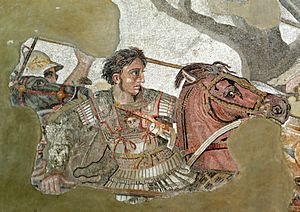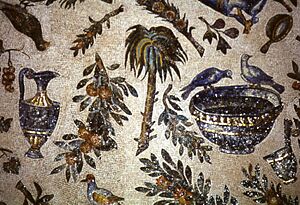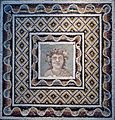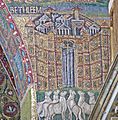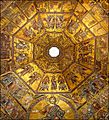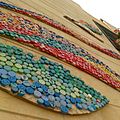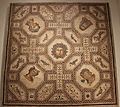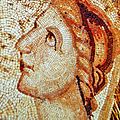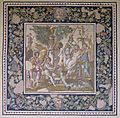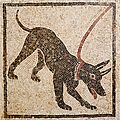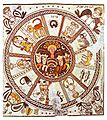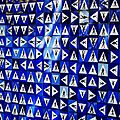Mosaic facts for kids
A mosaic is a special kind of art. It's made by decorating a surface with pictures and patterns. These designs are created using many small, colorful pieces. These pieces can be made of stone, glass, or tiles.
Mosaics can be found in many places. They are often used inside buildings on walls, floors, and ceilings. Sometimes, you can also see mosaics outdoors, like on sidewalks or pathways.
Contents
How Mosaics Are Made
Mosaics are created by carefully placing colored pieces into a special kind of glue called "mortar." Mortar is like a strong cement that holds the pieces firmly in place once it dries.
Some mosaics are made from smooth, round pebbles. These usually have only a few colors. Other mosaics use marble, which is a type of stone. Many mosaics, especially in Italy, are made from terracotta tiles. Terracotta is a type of clay that has been baked in a hot oven. These tiles come in many colors, making them great for creating colorful pictures and patterns.
You might even see some mosaic tiles that look like pure gold! These aren't actually solid gold. They are made of glass with a very thin layer of gold stuck to one side. The gold side is placed into the mortar. This way, the gold shines through the glass, but it can't be scratched off.
A Look Back: The History of Mosaics
Mosaics are very strong and can last for a long, long time. Many mosaics made by the Ancient Romans are still around today! You can find them in Italy, England, France, and other countries that were once part of the Roman Empire.
Many beautiful mosaics were made during the early Christian and Byzantine times. This was from about 300 AD to 1400 AD. You can see these in Italy, Greece, and other countries. Mosaics in churches often show pictures that tell stories from the Bible.
During the Medieval period, mosaics were a popular way to decorate churches in Italy. However, in countries like England, France, and Germany, people often preferred to use stained glass windows for decoration instead.
One of the most famous churches in Italy with amazing mosaic decorations is St. Mark's Basilica in Venice. In London, Westminster Cathedral also has many mosaics. The work on these mosaics started over 100 years ago and is still going on! Many mosaics at St. Mark's and Westminster Cathedral have shiny gold backgrounds.
Today, mosaics are still used in many different ways. They are often used to make public places in cities look brighter and more interesting. Modern mosaics can be made from all sorts of materials. This includes mosaic tiles, bathroom tiles, broken roof tiles, old dishes, broken mirrors, bits of metal, and even old bricks!
Explore More About Art
Gallery
-
This old guest house in China has a mosaic with a Chinese symbol
-
A Byzantine mosaic from Ravenna, Italy showing gold tiles
-
A mosaic from c.1900, Westminster Cathedral, London
-
A 20th century mosaic decorating a house in the Czech Republic
-
A modern mosaic made of bathroom tiles on a pavement in Wales
-
Cone mosaic courtyard from Uruk in Mesopotamia 3000 BC
-
A mosaic of the Kasta Tomb in Amphipolis depicting the abduction of Persephone by Pluto, 4th century BC
-
The Good Shepherd mosaic in the Mausoleum of Galla Placidia, Ravenna
-
Saint Peter mosaic from the Chora Church
-
Byzantine mosaic above the entrance portal of the Euphrasian Basilica in Poreč, Croatia (6th century)
-
A pre-Iconoclastic depiction of St. Demetrios at the Hagios Demetrios Basilica in Thessaloniki.
-
Mosaic of Christ Pantocrator from Hagia Sophia from the Deesis mosaic.
-
A mosaic from the Hagia Sophia of Constantinople (modern Istanbul), depicting Mary and Jesus, flanked by John II Komnenos (left) and his wife Irene of Hungary (right), c. 1118 AD
-
Saracen arches and Byzantine mosaics in the Cappella Palatina of Roger II of Sicily
-
Monreale mosaics: William II offering the Monreale Cathedral to the Virgin Mary
-
A “painting” made from tesserae in St Peter's Basilica, Vatican State, Italy
-
Jerusalem on the Madaba Map
-
Mosaic floor from the church on Mount Nebo (baptistery, 530)
-
The Transfiguration of Jesus in the Saint Catherine's Monastery
-
Detail from the mosaic floor of the Byzantine church of in Masada. The monastic community lived here in the 5th–7th centuries.
-
Early 12th-century Kievan mosaic depicting St. Demetrius.
-
Complex Mosaic patterns also known as Girih are popular forms of architectural art in many Muslim cultures. Tomb of Hafez, Shiraz, Iran
-
Islamic mosaics inside the Dome of the Rock in Palestine (c. 690)
-
The Umayyad mosaics of Hisham's Palace closely followed classical traditions
-
Golden mosaics in the dome of the Great Mosque in Corduba, Moorish Spain (965–970)
-
Mosaic art at Bonifacio High Street in Bonifacio Global City, Philippines
-
Tool table for ancient Roman mosaics at Roman villa of La Olmeda in Pedrosa de la Vega, Province of Palencia (Castile and León, Spain).
-
The mosaic of The Beauty of Durrës, late 4th century BC. Now in the National Historical Museum in Tirana
-
Cave canem mosaics ('Beware of the dog') were a popular motif for the thresholds of Roman villas
-
A small part of The Great Pavement, a Roman mosaic laid in AD 325 at Woodchester, Gloucestershire, England
-
The Zliten mosaic showing gladiators, 2nd century AD
-
Roman mosaic found at Calleva Atrebatum (Silchester)
-
Late Roman mosaics at Villa Romana La Olmeda, Spain, 4th-5th centuries AD
-
Judgment of Paris, marble, limestone and glass tesserae, 115–150 AD; from the Atrium House triclinium in Antioch-on-the-Orontes
Images for kids
-
From Pompeii, Casa di Orfeo National Archaeological Museum, Naples
-
Detail of a Paleochristian mosaic from the basilica of Santa Pudenziana in Rome, c. 410 AD, depicting Saint Pudentiana
-
Mosaic of Justinian I in Basilica of San Vitale, Ravenna
-
Another example of a Zodiac wheel on the floor of the synagogue, this time in Beit Alfa.
-
Mosaic of Menorah from Hammam Lif synagogue, Tunisia, 6th c. Brooklyn Museum
-
Art mosaic, University of Bremen, Germany.
-
A Hellenistic Greek mosaic depicting the god Dionysos as a winged daimon riding on a tiger, from the House of Dionysos at Delos in the South Aegean region of Greece, late 2nd century BC
-
This centaur mosaic was found on the site of the Roman emperor Hadrian's Villa near Tivoli, Italy. Altes Museum, Berlin.
See also
 In Spanish: Mosaico para niños
In Spanish: Mosaico para niños


